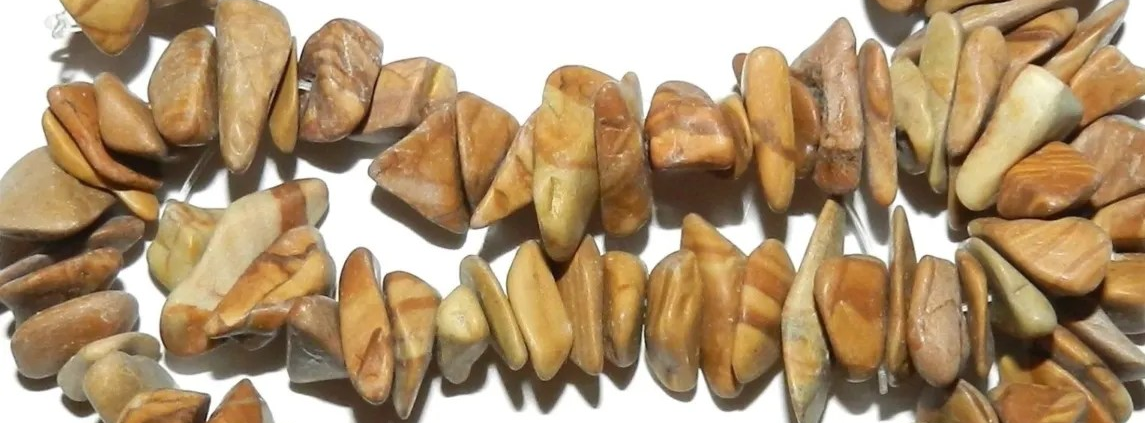Tigerskin Jasper
Tigerskin Jasper, with its unique striped or patterned appearance, is a captivating variety of jasper, a type of chalcedony mineral belonging to the broader quartz family. Known for its distinctive blend of brown, yellow, and cream-colored bands, Tigerskin Jasper has earned its place as both a sought-after ornamental stone and a geological curiosity. This mineral is often confused with Tiger’s Eye due to its name, but the two are different both in appearance and composition. While Tiger’s Eye is a fibrous variety of quartz with a silky luster, Tigerskin Jasper’s beauty comes from its opaque and banded or mottled appearance, giving it a “tiger-striped” aesthetic.

Contents
- Formation and Geologic Composition
- Coloration and Pattern Characteristics
- Geologic Origins and Deposits
- Physical and Chemical Properties
- Historical and Cultural Significance
- Conclusion
Formation and Geologic Composition
Jasper, including Tigerskin Jasper, forms through sedimentary processes. It is an opaque, microcrystalline variety of quartz (SiO₂) that gains its colors and patterns from a variety of mineral inclusions. These inclusions, including iron oxides, manganese, and other minerals, lend jasper its vast array of colors and patterns. Tigerskin Jasper’s characteristic stripes come from iron-rich minerals, which undergo oxidation and create a variety of brown, tan, and yellow hues.

The formation of jasper stones typically involves siliceous sediments that were originally part of a sedimentary environment, such as sand and silt beds, which undergo diagenesis – a transformation of sediments to solid rock – under specific conditions of pressure and heat. Over time, silica-rich water percolates through these sediments, filling any available pore spaces, and crystallizes into microcrystalline quartz. The inclusions, impurities, and varied mineral compositions are locked within the silica matrix, creating the stunning patterns seen in Tigerskin Jasper.
Coloration and Pattern Characteristics

The colors in Tigerskin Jasper arise primarily due to iron oxide inclusions. The warm, earthy tones – ranging from brown and yellow to reddish-brown – are direct indicators of oxidized iron. In some cases, black or dark bands may appear due to the presence of manganese oxides. Unlike Tiger’s Eye, which has a silky chatoyancy due to fibrous crocidolite (a type of asbestos), Tigerskin Jasper lacks this fibrous structure, which is why it appears solid rather than chatoyant.
Patterns in Tigerskin Jasper range from stripes that mimic a tiger’s fur to mottled patches resembling animal skin. The layering within these stones is typically caused by periodic changes in mineral-rich solutions during the stone’s formation. Variations in mineral inclusions and differing oxidation states create contrasting bands and patches that add to the stone’s unique visual appeal.
Geologic Origins and Deposits

Jasper stones, including Tigerskin Jasper, are found in various geological settings worldwide. They are typically associated with areas of significant silica deposition, such as ancient riverbeds, hydrothermal veins, and volcanic terrains. Countries with abundant jasper deposits include Brazil, India, Russia, Madagascar, and the United States. These regions are home to volcanic and sedimentary environments where silica-rich fluids once percolated through rocks, allowing for the slow deposition and crystallization of jasper over millions of years.
In volcanic settings, the silica-rich fluids required for jasper formation are often released by hydrothermal activity. As these fluids flow through rock fractures and cooling lava flows, they deposit layers of silica, which eventually become jasper. In sedimentary contexts, jasper formation is linked to the slow accumulation of siliceous sediments, where silica from water seepage fills and cements the available pore spaces in the surrounding rock. The particular environment in which Tigerskin Jasper forms influences its final color and pattern, with iron and manganese minerals contributing to the stone’s characteristic tiger-like appearance.
Physical and Chemical Properties

Tigerskin Jasper, like all jasper, is composed primarily of silicon dioxide (SiO₂) and has a hardness of about 6.5 to 7 on the Mohs hardness scale. This makes it relatively durable and suitable for a wide variety of uses, from jewelry to decorative carvings. The density of jasper generally ranges from 2.58 to 2.91 g/cm³, depending on its exact composition and the presence of various mineral inclusions. It is an opaque stone, meaning it does not allow light to pass through, which gives it a solid and sometimes earthy appearance, distinct from other semi-translucent chalcedony varieties.
Chemically, jasper is resistant to most environmental degradation processes due to its quartz composition. However, due to the iron oxide content, Tigerskin Jasper may undergo slight weathering and develop a patina if exposed to the elements for extended periods.
Historical and Cultural Significance

Throughout history, jasper stones, including Tigerskin Jasper, have been valued for their beauty and believed metaphysical properties. Ancient civilizations, including the Egyptians, Greeks, and Romans, treasured jasper as a protective stone, often using it in jewelry, amulets, and as a protective talisman. Its resemblance to animal skin may have led early people to associate it with animals and strength, enhancing its cultural importance.
Modern Uses and Aesthetic Appeal
Today, Tigerskin Jasper is popular in jewelry and as a decorative stone. Its distinctive earthy tones complement both metal and beadwork, making it a favored choice for rings, necklaces, bracelets, and other jewelry items. The stone is also used in larger decorative objects like cabochons, carvings, and ornamental sculptures, where its unique patterns are displayed to their fullest.
Conclusion
Tigerskin Jasper stands as a testament to nature’s ability to create intricate and beautiful designs within solid rock. From its geological formation through sedimentary and volcanic processes to its striking colors due to iron and manganese inclusions, Tigerskin Jasper captures both the artistry and complexity of the Earth’s geologic processes. Its tiger-striped appearance, combined with its resilient quartz-based composition, makes it a stone of both aesthetic appeal and geological interest. Whether in jewelry or as a collector’s item, Tigerskin Jasper offers a connection to the Earth’s rich geological history, showcasing the beauty that can emerge from millions of years of natural processes.



Leave a Reply
Want to join the discussion?Feel free to contribute!